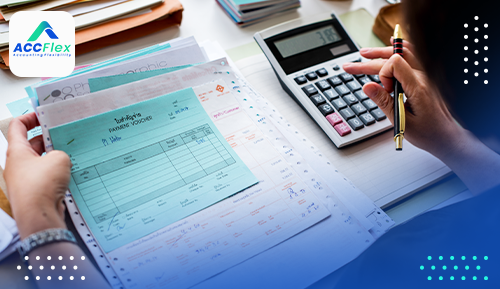Auditing accounts payable is very important because it is related to the payments, and therefore the transaction of the treasury or the bank is also linked to the company's warehouses, both raw materials warehouses and supplies, and also linked to the value-added tax (VAT) and the tax of withholding and collection, and there to be control over accounts payable, there are a set of steps required which are
1- Auditing the documentary cycle of procurement and payments, whether cash or credit.
2- Auditing the accounts payable trial balance, in the case that there are debit balances in accounts payable, these accounts must be audited and ensure that the journal entries are treated properly and that the debit balance in accounts payable is correct and samples from the suppliers should be taken whose balances are large and auditing the accounts payable journal entry and payment journal entry and ensure that all procedures are correct.
3- Auditing the invoices of the main suppliers and also auditing the payment and making sure that the invoices are recorded properly and also auditing the payments, if payment was paid to the supplier from the treasury, there must be a receipt from the treasury with a receipt from the supplier including receipt stating and with it an authorization, also, if the payment is by check, then it must the check is crossed and the receipt of the supplier is also by the check value, and the copy of the check must be attached with the payment journal entry and also the supplier statement.
4- Monitoring the notes payable account is very important in the sense that if there is a balance of one million pounds in the notes payable there must be an analysis of this balance for each check and the value of the check and the name of the supplier and bank's name and the due date.
5- Auditing the purchase invoices and their impact on the company's warehouses, meaning that the transaction of the items that the company purchased is audited and the impact of that on the inventory balance in terms of quantity and amount.
6- Comparing accounts payable balances for the current period with the previous period.
7- Auditing the account payable opening balances, reconciliation them with the accounts payable closing balances of the previous period.
8- The nature of accounts payable is that they are credit and therefore any debit balances that must be shown in the accounts payable- advance payments as a current asset, must be audited in detail and determine the reason for that the balance is debit in the sense of whether it is wrong in treating the journal entries nor that an advance payment was paid to a supplier before it the supplier to the receipt of goods, and this is one of the most important primary duties for any auditor or officer of the accounts payable department to prevent manipulation.
9- Auditing the accounts payable reconciliation is one of the important matters that the auditor should make sure to make sure the balances are reconciliation and in the case of a difference in the balances, determining the reasons for the difference and work to solve them.
10- Monitoring the balances that do not have a transaction from a large period and find out the reason for stopping it in the sense of accounts payable whose balance is credit of 50,000 and we discovered that the balance is credit since for a period let it be 6 months, is the reason that originally the supplier has not been paid yet for any reason or is there a wrong treatment of the accounts payable journal entries for purchase and payment and the journal entry was treated by mistake to another supplier similar by name or code.
Also, if there is a debit balance in accounts payable a long time ago, it is necessary to determine the reason, have advance payments been paid? and until now the service has not been performed or the supplier has not supplied the raw materials or is there another reason that the supplier has supplied or performed the service but an invoice has not been brought by the supplier and therefore, there has been not created accounts payable journal entry, so the accounts payable balance still debit by the value of the payment that was paid.
Financial analysis of Accounts Payable
Financial analysis of accounts payable and determining financial ratios enable the auditor, accounts payable officer or financial analyst to analyze the trial balance for a period and read and understand the accounts payable of ratios analysis and give an initial idea of the status of accounts payable and purchases during the period
1- Accounts Payable Turnover Ratio
AP Turnover = Net Credit Purchases/ Average Accounts Payable
This indicator shows us how many times accounts payable are paid over a given fiscal period and the company's ability to get a credit period from suppliers when purchasing
The low ratio may be positive or negative
Positive if it is the result of the company's ability to get a large credit period from suppliers
Negative if it is the result of the company's inability to pay on time, which affects the company's reputation
This indicator shows how many times that the accounts payable turnover over the year and this is of course if you want to determine the total accounts payable turnover, but of course, it is necessary to determine the turnover ratio to each supplier separately
Also, by determining the accounts payable turnover ratio, the average payment period to each supplier separately or the average payment period to suppliers can be calculated, and of course, an analysis of the trial balance is on Excel sheet to be flexible
2- Average Payment Period (APP)
The second ratio in the analysis of accounts payable is the average payment period, which is
= Average Accounts Payable/ (Total Credit Purchases/ Days)
In contrast to the average collection period, the higher average payment period, the better, where it shows the company's ability to use one of the types of commercial financing which is trade credit, this is the best type of commercial financing where interest is not paid on it as is the case the enterprise got a loan, for example, and by analyzing the payment period for each supplier separately in a way to be used in negotiating with the supplier by increasing the payment period or get from it discounts as a result of regular payment, many negotiations for the enterprise, the period can be 30 days, 60 days, 90 days, 180 days, or 360 days, meaning that according to the period in which the average payment period is measured, which must be the same period of the accounts payable turnover ratio.
Practical Example
Account payable balance, Al-Salam Company, on 1/10/2019 amounted to 400,000 pounds and the net credit purchases amounted to 900,000 and the account payable balance at the end of the period on 31/12/2019 amounted to 200,000 pounds
To calculate the average payment period, you must first determine the accounts payable turnover ratio
First, Average Accounts Payable = (Opening Accounts Payable + Closing Accounts Payable) / 2
= (400 + 200) / 2 = 300,000 pounds
Accounts Payable Turnover Ratio = Total Credit Purchases / Average Accounts Payable
Accounts Payable Turnover Ratio = 900/300 = 3 times
Average Payment Period = 3/30 = 10 days
Which means the company pays the invoice to this supplier every 10 days.
Another ratio we could use to read the trial balance is
Debt to each supplier ratio to net credit purchases
These ratios are useful for determining the debt to the supplier during the period, and let it be the third quarter, whether this debt belongs to invoices for the current period (the third quarter) or there are invoices for the previous period using the same data as the previous example
Debt ratio of purchases during the period = total debt to supplier / net purchases during the period
Debt ratio of purchases during the period = 200/900 = 22.22%
This ratio means that, until the end of the period, 22.22% of the value of the purchases for the current period has not been paid
And 77.78% of the value of purchases for the current period has been paid in addition to the debts of the previous period
There is another ratio that is complementary to this ratio, which the paying invoices of purchases ratio for the current period
But first, it is necessary to determine the payments to the supplier during the period
Using the same data as the previous example to calculate payments to the supplier
= Opening balance+ Net Purchases during the period - Closing Accounts Payable
= 400 + 900-200 = 1100
The value of the payments to the supplier during the period amounted to 1100 pounds
And to calculate the ratio of what was paid from the purchases invoices of the current period during the period
= (Payments during the period - Account Payable Opening Balance) / Net Purchases during the period
= (1100-400) / 900 = 77.78%
Thus, 77.78% + 22.22% = 100%
These ratios make it easier to read accounts payable and determining the accounts payable status during the fiscal period.










